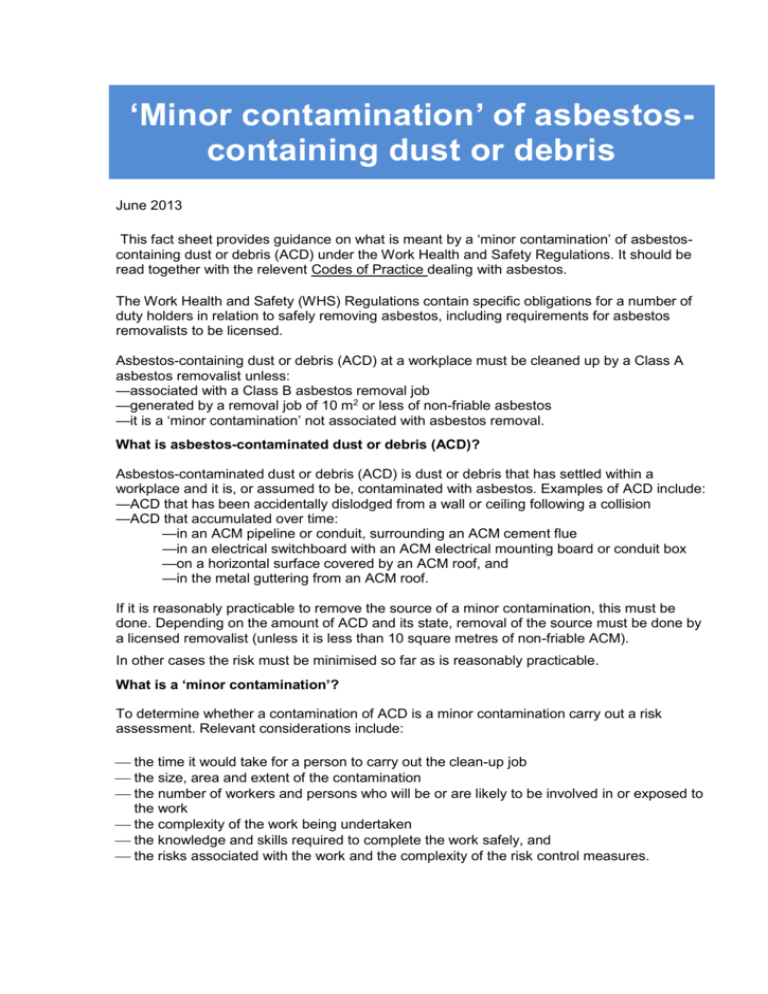*Minor contamination*of asbestos-containing dust or debris fact sheet
advertisement

‘Minor contamination’ of asbestoscontaining dust or debris June 2013 This fact sheet provides guidance on what is meant by a ‘minor contamination’ of asbestoscontaining dust or debris (ACD) under the Work Health and Safety Regulations. It should be read together with the relevent Codes of Practice dealing with asbestos. The Work Health and Safety (WHS) Regulations contain specific obligations for a number of duty holders in relation to safely removing asbestos, including requirements for asbestos removalists to be licensed. Asbestos-containing dust or debris (ACD) at a workplace must be cleaned up by a Class A asbestos removalist unless: —associated with a Class B asbestos removal job —generated by a removal job of 10 m2 or less of non-friable asbestos —it is a ‘minor contamination’ not associated with asbestos removal. What is asbestos-contaminated dust or debris (ACD)? Asbestos-contaminated dust or debris (ACD) is dust or debris that has settled within a workplace and it is, or assumed to be, contaminated with asbestos. Examples of ACD include: —ACD that has been accidentally dislodged from a wall or ceiling following a collision —ACD that accumulated over time: —in an ACM pipeline or conduit, surrounding an ACM cement flue —in an electrical switchboard with an ACM electrical mounting board or conduit box —on a horizontal surface covered by an ACM roof, and —in the metal guttering from an ACM roof. If it is reasonably practicable to remove the source of a minor contamination, this must be done. Depending on the amount of ACD and its state, removal of the source must be done by a licensed removalist (unless it is less than 10 square metres of non-friable ACM). In other cases the risk must be minimised so far as is reasonably practicable. What is a ‘minor contamination’? To determine whether a contamination of ACD is a minor contamination carry out a risk assessment. Relevant considerations include: the time it would take for a person to carry out the clean-up job the size, area and extent of the contamination the number of workers and persons who will be or are likely to be involved in or exposed to the work the complexity of the work being undertaken the knowledge and skills required to complete the work safely, and the risks associated with the work and the complexity of the risk control measures. A competent person should be engaged to do the risk assessment if you are unsure about what needs to be done or if you do not have the skills or knowledge to do the assessment yourself. Example 1 Removing a minor contamination of ACD from a small area, for example an electrical box Time 10 minutes for one worker Area Small Distribution No further spread of ACD to adjoining areas Exposure Possible release of asbestos fibres during the clean-up is minimal, contamination can be removed with a H Class HEPA filtered vacuum Class A licensed removalist not required—the Code of Practice: How to Manage and Control Asbestos in the Workplace applies. Example 2 Minor contamination generated from drilling into a wall/ceiling with ACM Time 10 minutes for one worker Area Small Distribution Minimal spread of ACD to adjoining areas Exposure Possible release of asbestos fibres during the clean-up minimal, contamination easy to remove with wet wiping Class A licensed removalist not required—the Code of Practice: How to Manage and Control Asbestos in the Workplace applies. Example 3 A large warehouse has surfaces covered in asbestos-contaminated dust. The dust has come from the asbestos cement roof which has since been enclosed with a false ceiling Time Clean-up will take 4 hours Area Medium to large area Distribution ACD on a number of different surfaces in adjoining areas Exposure Possible release of asbestos fibres during the clean-up is high, enclosure required Class A licensed required. 2 Example 4 A house roof has been cleaned illegally using high pressure water leaving dried ACD spread over a large area Time Clean-up will take 2 days Area Medium to large area Distribution ACD on a number of different surfaces in adjoining areas Exposure Possible release of asbestos fibres during the clean-up is high Class A licensed required with clean up procedures specified by WHS Regulator. Example 5 Minor ACD contamination generated by storm damage to a fibro structure Time 1 hour for one worker Area Medium Distribution minimal spread of ACD to adjoining areas Exposure Possible release of asbestos fibres during the clean-up minimal, contamination easy to remove with wetting down and picking up bonded pieces Class A licensed removalist not required—the Code of Practice: How to Manage and Control Asbestos in the Workplace applies, and any other guidance provided by your local WHS Regulator. Organising a clean-up of a ‘minor contamination’ Refer to the Code of Practice: How to Safely Remove Asbestos (the Code). In summary key steps are: Step 1 Step 2 Isolate the area and determine whether asbestos is present—you may need to assume that asbestos is present. Check the asbestos register (if any) for the workplace. Determine whether the contamination is minor—you will need to do a risk assessment for this—refer to the Code and any other guidance provided by your local WHS regulator. If unsure—hire a competent person to do the risk assessment or a Class A licensed asbestos removalist for the clean-up job. If the ACD contamination is minor: Step 3 Organise the clean-up by following the Code. You can also check to see whether any additional guidance is provided by your local WHS Regulator. This includes: —collecting all cleaning items for example disposable cleaning rags, a bucket of water, 200 micron plastic sheeting, waste disposal bags, spare PPE warning signs and an asbestos vacuum cleaner (H Class HEPA filtered vacuum) if required —establishing the removal area and move all items out of the area or cover them with 200 micron plastic sheeting if they could be contaminated during the clean up —organising personal protective equipment (PPE) including disposable coveralls with hood and boots; use boots without laces as laced boots can be difficult to 3 Step 4 Step 5 Step 6 Step 7 decontaminate, and —organising respiratory protection; the respiratory protection for this task is a disposable P1 or P2 respirator provided that a proper fit can be assured. Clean-up the minor contamination: —pick up any asbestos debris; use an industrial vacuum cleaner fitted with a H Class HEPA filter to collect the asbestos-contaminated dust and use damp cloths to wet wipe surfaces —place the waste into a 200 micron plastic waste bag or suitable alternate waste container dedicated for asbestos waste that is clearly labelled with an appropriate warning sign indicating asbestos waste, and —after all the debris and contaminated dust, used rags and waste have been placed in waste containers and all tools have been cleaned, begin the personal decontamination process. Carry out personal decontamination in a designated area. The method of personal decontamination may vary. For example: —clean the disposable coveralls and P1 respirator while still being worn; coveralls can be cleaned using a H Class HEPA vacuum, damp rag or fine water spray and the respirator can be cleaned with a wet rag or cloth —while the respirator is still being worn, remove coveralls turning them inside-out to entrap any remaining contamination and then place them into an asbestos waste bag. Remove the respirator and place it into an asbestos waste bag or waste container dedicated for asbestos waste. Visually inspect the area to ensure that all the dust and debris is removed. Dispose of the waste lawfully: —ensure all waste bags are goose-necked, the exterior cleaned then double bagged and all waste containers are sealed and labelled —place all waste containers in a secure storage facility or transport vehicle for disposal, and —transport and dispose of the waste in accordance with applicable environmental protection requirements. Contact Us General Enquiries: 1300 551 832 Email: info@swa.gov.au Postal Address: GPO Box 641 Canberra ACT 2601 Media Enquiries: 0434664294 4








